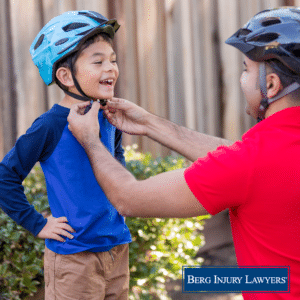Buying a Safe Bicycle Helmet
Home » Blog » Buying a Safe Bicycle Helmet
by Staff Blogger | August 10th, 2020
 Here’s a sobering concept: the bicycle helmet you’ve been wearing might not meet federal safety standards. You might assume, as many people do, that all bicycle helmets sold in the U.S. are required to meet the Consumer Product Safety Commission’s (CPSC) standards, but the reality isn’t as clear-cut.
Technically, helmets are required to meet those standards, but in the online retail world, many bicycle helmets, some of which are widely sold and purchased, do not meet those standards. Consumer Reports researchers alone identified 13 helmets that didn’t include a CPSC compliance label. And many of those non-compliant helmets were offered on some of the biggest online shopping platforms.
In short, be extra careful when you buy a bicycle helmet. But what exactly should you be looking for? Let’s find out.
Here’s a sobering concept: the bicycle helmet you’ve been wearing might not meet federal safety standards. You might assume, as many people do, that all bicycle helmets sold in the U.S. are required to meet the Consumer Product Safety Commission’s (CPSC) standards, but the reality isn’t as clear-cut.
Technically, helmets are required to meet those standards, but in the online retail world, many bicycle helmets, some of which are widely sold and purchased, do not meet those standards. Consumer Reports researchers alone identified 13 helmets that didn’t include a CPSC compliance label. And many of those non-compliant helmets were offered on some of the biggest online shopping platforms.
In short, be extra careful when you buy a bicycle helmet. But what exactly should you be looking for? Let’s find out.
How Do You Know Which Helmets Are Safe?
First things first, look for a helmet with a label stating that it complies with the CPSC’s standard. It’s possible that labels on some of these helmets are counterfeit, but it’s a good place to start.
Next, Consumer Reports says that you should look for “the name, address, and telephone number of the manufacturer or importer issuing the certificate.” In some cases, the information will be that of the private labeler of the helmet.
Next, look for a serial number or other information that identifies the production lot of the product. This will also allow you to find out the month and year the helmet was manufactured. All this information can help you verify that the helmet you purchased does in fact comply with federal safety standards.
Though online shopping tempts helmet buyers through easy shipping and budget prices, the safest approach is to visit a local shop that sells reputable products.
Choosing a helmet in person not only makes it easier to inspect it for quality, but it also gives you a chance to try it on. Helmet fit is vital when it comes to safety. Helmets that are too small or too big don’t protect as well as helmets that fit properly.
Curious about California’s bicycle safety laws? We’ve compiled a list of everything you need to know in another blog post.
Picking the Right Helmet for You
Now that you know how to avoid buying an unsafe helmet, it’s important to look for a helmet that fits your specific needs. This means finding a helmet with the proper fit that’s made for your style of biking (road, mountain, or recreational, for example).
Take some time to research the level of protection each option you’re considering offers. Look at the weight, shielding, and straps to determine whether a helmet will be comfortable.
Caring for Your Helmet
Once you have a helmet you like, make sure you follow best practices to get the most out of it. That means cleaning it frequently and making sure the straps and buckles fit securely each time you ride.
If your helmet is ever struck or damaged, even just a bit, stop using it and buy a new one. One small impact can greatly reduce a helmet’s effectiveness, so don’t take any chances. Don’t donate it or give it away, as it could put another cyclist at risk during a crash.
At Berg Injury Lawyers, We Have Bicyclists’ Backs
Our California bicycle accident attorneys have represented many cyclists in personal injury claims, and we always work hard to get them fair treatment and compensation. Whether an injury is caused by a defective product or a negligent driver, bicyclists should know that they almost always have legal options available, as long as they act fast, before the statute of limitations closes.
If you or a loved one was injured in a bicycle accident, contact our team to schedule a free consultation.
 Here’s a sobering concept: the bicycle helmet you’ve been wearing might not meet federal safety standards. You might assume, as many people do, that all bicycle helmets sold in the U.S. are required to meet the Consumer Product Safety Commission’s (CPSC) standards, but the reality isn’t as clear-cut.
Technically, helmets are required to meet those standards, but in the online retail world, many bicycle helmets, some of which are widely sold and purchased, do not meet those standards. Consumer Reports researchers alone identified 13 helmets that didn’t include a CPSC compliance label. And many of those non-compliant helmets were offered on some of the biggest online shopping platforms.
In short, be extra careful when you buy a bicycle helmet. But what exactly should you be looking for? Let’s find out.
Here’s a sobering concept: the bicycle helmet you’ve been wearing might not meet federal safety standards. You might assume, as many people do, that all bicycle helmets sold in the U.S. are required to meet the Consumer Product Safety Commission’s (CPSC) standards, but the reality isn’t as clear-cut.
Technically, helmets are required to meet those standards, but in the online retail world, many bicycle helmets, some of which are widely sold and purchased, do not meet those standards. Consumer Reports researchers alone identified 13 helmets that didn’t include a CPSC compliance label. And many of those non-compliant helmets were offered on some of the biggest online shopping platforms.
In short, be extra careful when you buy a bicycle helmet. But what exactly should you be looking for? Let’s find out.


